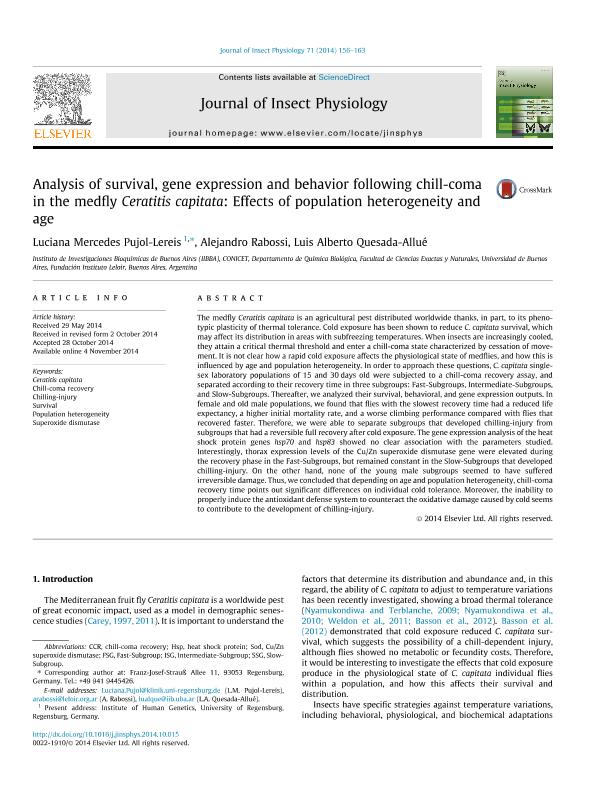Mostrar el registro sencillo del ítem
dc.contributor.author
Pujol Lereis, Luciana Mercedes

dc.contributor.author
Rabossi, Alejandro

dc.contributor.author
Quesada Allue, Luis Alberto

dc.date.available
2017-08-28T18:41:49Z
dc.date.issued
2014-12
dc.identifier.citation
Pujol Lereis, Luciana Mercedes; Rabossi, Alejandro; Quesada Allue, Luis Alberto; Analysis of survival, gene expression and behavior following chill-coma in the medfly Ceratitis capitata: effects of population heterogeneity and age; Elsevier; Journal of Insect Physiology; 71; 12-2014; 156-163
dc.identifier.issn
0022-1910
dc.identifier.uri
http://hdl.handle.net/11336/23136
dc.description.abstract
The medfly Ceratitis capitata is an agricultural pest distributed worldwide thanks, in part, to its phenotypic plasticity of thermal tolerance. Cold exposure has been shown to reduce C. capitata survival, which may affect its distribution in areas with subfreezing temperatures. When insects are increasingly cooled, they attain a critical thermal threshold and enter a chill-coma state characterized by cessation of movement. It is not clear how a rapid cold exposure affects the physiological state of medflies, and how this is influenced by age and population heterogeneity. In order to approach these questions, C. capitata single-sex laboratory populations of 15 and 30 days old were subjected to a chill-coma recovery assay, and separated according to their recovery time in three subgroups: Fast-Subgroups, Intermediate-Subgroups, and Slow-Subgroups. Thereafter, we analyzed their survival, behavioral, and gene expression outputs. In female and old male populations, we found that flies with the slowest recovery time had a reduced life expectancy, a higher initial mortality rate, and a worse climbing performance compared with flies that recovered faster. Therefore, we were able to separate subgroups that developed chilling-injury from subgroups that had a reversible full recovery after cold exposure. The gene expression analysis of the heat shock protein genes hsp70 and hsp83 showed no clear association with the parameters studied. Interestingly, thorax expression levels of the Cu/Zn superoxide dismutase gene were elevated during the recovery phase in the Fast-Subgroups, but remained constant in the Slow-Subgroups that developed chilling-injury. On the other hand, none of the young male subgroups seemed to have suffered irreversible damage. Thus, we concluded that depending on age and population heterogeneity, chill-coma recovery time points out significant differences on individual cold tolerance. Moreover, the inability to properly induce the antioxidant defense system to counteract the oxidative damage caused by cold seems to contribute to the development of chilling-injury.
dc.format
application/pdf
dc.language.iso
eng
dc.publisher
Elsevier

dc.rights
info:eu-repo/semantics/openAccess
dc.rights.uri
https://creativecommons.org/licenses/by-nc-sa/2.5/ar/
dc.subject
Chill-Coma Recovery
dc.subject
Survival
dc.subject
Ceratitis Capitata
dc.subject
Population Heterogeneity
dc.subject.classification
Bioquímica y Biología Molecular

dc.subject.classification
Ciencias Biológicas

dc.subject.classification
CIENCIAS NATURALES Y EXACTAS

dc.title
Analysis of survival, gene expression and behavior following chill-coma in the medfly Ceratitis capitata: effects of population heterogeneity and age
dc.type
info:eu-repo/semantics/article
dc.type
info:ar-repo/semantics/artículo
dc.type
info:eu-repo/semantics/publishedVersion
dc.date.updated
2017-08-14T19:55:41Z
dc.identifier.eissn
1879-1611
dc.journal.volume
71
dc.journal.pagination
156-163
dc.journal.pais
Países Bajos

dc.journal.ciudad
Amsterdam
dc.description.fil
Fil: Pujol Lereis, Luciana Mercedes. Consejo Nacional de Investigaciones Científicas y Técnicas. Oficina de Coordinación Administrativa Parque Centenario. Instituto de Investigaciones Bioquímicas de Buenos Aires. Fundación Instituto Leloir. Instituto de Investigaciones Bioquímicas de Buenos Aires; Argentina. Universidad de Buenos Aires. Facultad de Ciencias Exactas y Naturales. Departamento de Química Biológica; Argentina
dc.description.fil
Fil: Rabossi, Alejandro. Consejo Nacional de Investigaciones Científicas y Técnicas. Oficina de Coordinación Administrativa Parque Centenario. Instituto de Investigaciones Bioquímicas de Buenos Aires. Fundación Instituto Leloir. Instituto de Investigaciones Bioquímicas de Buenos Aires; Argentina. Universidad de Buenos Aires. Facultad de Ciencias Exactas y Naturales. Departamento de Química Biológica; Argentina
dc.description.fil
Fil: Quesada Allue, Luis Alberto. Consejo Nacional de Investigaciones Científicas y Técnicas. Oficina de Coordinación Administrativa Parque Centenario. Instituto de Investigaciones Bioquímicas de Buenos Aires. Fundación Instituto Leloir. Instituto de Investigaciones Bioquímicas de Buenos Aires; Argentina. Universidad de Buenos Aires. Facultad de Ciencias Exactas y Naturales. Departamento de Química Biológica; Argentina
dc.journal.title
Journal of Insect Physiology

dc.relation.alternativeid
info:eu-repo/semantics/altIdentifier/url/http://www.sciencedirect.com/science/article/pii/S0022191014002108
dc.relation.alternativeid
info:eu-repo/semantics/altIdentifier/doi/https://doi.org/10.1016/j.jinsphys.2014.10.015
Archivos asociados
